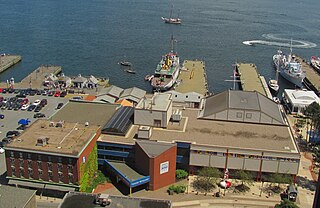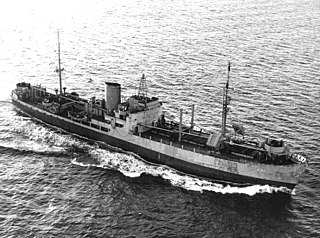
Hants County is a historical county and census division of Nova Scotia, Canada. Local government is provided by the West Hants Regional Municipality, and the Municipality of the District of East Hants.

Yarmouth is a town in southwestern Nova Scotia, Canada. A port town, its industries include fishing and tourism. It is the terminus of a ferry service to Bar Harbor, Maine, run by Bay Ferries.

The Maritime Museum of the Atlantic is a maritime museum located in downtown Halifax, Nova Scotia, Canada.

HMCS Armentières was one of twelve Battle-class naval trawlers used by the Royal Canadian Navy (RCN). Armentières entered service in 1918 near the end of the First World War on the Atlantic coast of Canada. Following the war, the ship was transferred to the Department of Marine and Fisheries for a short period before reverting to RCN service in 1923 on the Pacific coast of Canada. The ship sank in 1925, was raised and re-entered service, remaining with the fleet through the Second World War as an examination vessel at Prince Rupert, British Columbia. After the end of the war, the vessel entered mercantile service becoming A.G. Garrish in 1947, later renamed Arctic Rover in 1958, Laforce in 1962 and Polaris in 1973. The ship's registry was deleted in 1991.

Cisne Branco is a tall ship of the Brazilian Navy based at Rio de Janeiro, Brazil, to diplomatic operations worldwide. The name means "white swan." It is a full-rigged ship built in Amsterdam, Netherlands by Damen Shipyard. Her keel was laid on 9 November 1998, and she was christened and launched on 4 August 1999, delivered to the Brazilian Navy on 4 February 2000. The vessel was commissioned as a Brazilian naval vessel on 9 March 2000. Its sister ship is Stad Amsterdam.

USS Pontiac (AF-20) was the Danish refrigerated cargo ship Australian Reefer that sought refuge in the neutral United States when Germany occupied Denmark in April 1940. In 1941 the United States seized 40 Danish ships idle in its ports with Australian Reefer being among those ships.

John O'Brien (1831–1891) was a Canadian marine artist. He excelled at ship portraits combined with dramatic storm scenes.

William D. Lawrence was a full-rigged sailing ship built in Maitland, Nova Scotia, along the Minas Basin and named after her builder, the merchant and politician William Dawson Lawrence (1817–1886).
Kings County was a four-masted barque built in 1890 at Kingsport, Nova Scotia on the Minas Basin. She was named to commemorate Kings County, Nova Scotia and represented the peak of the county's shipbuilding era. Kings County was one of the largest wooden sailing vessels ever built in Canada and one of only two Canadian four-masted barques. At first registered as a four-masted full-rigged ship, she was quickly changed to a barque after her June 2 launch. More than three thousand people from Kings and Hants counties attended the launch. She survived a collision with an iceberg on an 1893 voyage to Swansea, Wales. Like many of the large wooden merchant ships built in Atlantic Canada, she spent most of her career far from home on trading voyages around the world. In 1909, she returned to the Minas Basin for a refit at Hantsport and loaded a large cargo of lumber. In 1911 she became the largest wooden ship to enter Havana Harbour when she delivered a cargo of lumber and was briefly stranded. She was lost a few months later on a voyage to Montevideo, Uruguay when she ran aground in the River Plate. Too damaged to repair, she was scrapped in Montevideo where her massive timbers were visible for many years.
Hamburg was a three masted barque built in 1886 at Hantsport, Nova Scotia. She was the largest three masted barque ever built in Canada.
Research was a full-rigged ship built in Yarmouth, Nova Scotia which was famous for a determined and courageous crew who replaced her rudder eight times to survive a crippling North Atlantic storm in 1866. Research was built in 1861 for the fleet of Thomas Killam and was the largest vessel built to that date in Yarmouth County, Nova Scotia. In the fall of 1866 on a voyage from Quebec to Glasgow, Scotland, her rudder was badly damaged in a sudden violent storm as the ship left the Gulf of Saint Lawrence at the beginning of her voyage. The rudder subsequently broke off entirely but was replaced by eight different jury rigged rudders which allowed the drifting and battered vessel to cross the ocean and reach her destination after 88 days. George Churchill, the captain of Research and Aaron Churchill, the first mate who carried out most of the repairs in the water, were celebrated for their courage, skill and determination. They both enjoyed the nickname "Rudder Churchill" for the rest of their careers. The ship was sold to owners in Saint John, New Brunswick in 1872 and then sold out of British registry a year later.
County of Yarmouth was a full-rigged ship built in Belliveau's Cove, Nova Scotia in 1884. She was the largest wooden ship ever built for shipowners in Yarmouth County, Nova Scotia, and the second largest wooden ship ever built in Canada, only a few tons less than the ship William D. Lawrence. The ship was one of a series of very large wooden ships proudly named after major shipbuilding counties of Nova Scotia at the end of the Age of Sail. William D. Lovitt, owner of a fleet of ships from Yarmouth, began as the sole owner. The ship enjoyed a profitable decade of service circling the globe several times but most often trading between South American, Canadian and British ports. She survived a serious grounding at Low Point, Cape Breton in 1893. After being dismasted in December 1895, she was to be broken up at Grimsby, England but was purchased by the government of Argentina as a school ship.
Dei Gratia was a Canadian brigantine built in Bear River, Nova Scotia in 1871. The brigantine was named after the Latin phrase for "By the Grace of God". She became famous in 1872 when, under the command of David Reed Morehouse, she discovered the ghost ship Mary Celeste without any crew near the Azores. They were 400 miles (640 km) east of the Azores on 5 December 1872. Morehouse and his crew took the derelict Mary Celeste to Gibraltar and claimed the brigantine as salvage. They were at first subjected to suspicion by Gibraltar's Attorney General, but the Vice Admiralty Court later approved their salvage prize and commended the crew for their resourcefulness and courage. The hefty court expenses of the extensive probe reduced the salvage compensation, which was originally set at roughly $8,300. Only a sixth of the money was really paid.

Canada was a full-rigged ship built in 1891 at Kingsport, Nova Scotia on the Minas Basin and was the largest sailing ship operated in Canada when launched in 1891. Canada was built and owned by Charles Rufus Burgess of nearby Wolfville, Nova Scotia. Despite the decline in wooden shipbuilding, Burgess saw that there was still potential for very large wooden sailing ships to make profits in the twilight days of the wooden sailing ship era. He had built the barque Kings County, the previous year, the largest four-masted barque ever built in Canada. Burgess planned to make Canada to be the largest sailing ship ever built in Canada, but damage, during harvesting, to a timber intended for the keel caused her length to be trimmed by ten feet making Canada slightly smaller than the ship William D. Lawrence built in 1874. However, as the William D. Lawrence had been sold to Norwegian owners and renamed in 1883, the ship Canada still claimed the honour of being the largest sailing ship under the Canadian flag at the time of her launch. Between 75 and 150 men were employed in building the ship. Canada was designed by master builder Ebenezer Cox who was in charge of the Burgess Shipyard in Kingsport where he had built ships since the 1860s and was regarded at the time to have built more ships than any man in Canada. The construction cost $111,000. Her interior included a finely outfitted captain's cabin, finished in walnut, ash and rosewood with a full dining room, office and bathroom. Her launch at noon on July 6, 1891 attracted 5,000 people from all across Western Nova Scotia, brought by multiple special trains run by the Cornwallis Valley Railway. It was regarded as the biggest event in the history of the village. A tug took the completed hull of Canada from the launch at Kingsport to Saint John, New Brunswick where the masting, rigging and outfitting was completed at the Customs House Wharf. Her immense size attracted hundreds to the Saint John waterfront to see Canada depart on September 1, 1891 for her maiden voyage, carrying with a cargo of lumber worth $144,109 bound for Liverpool, England. Classed A1 by Lloyd's Register for 14 years, Canada made several fast passages between South America and Australia. However by 1900, the ship was facing stif competition for cargoes from the growing numbers of general cargo steamships. Canada was converted to a gypsum barge in 1910, carrying gypsum from Windsor, Nova Scotia to Staten Island, New York for the Gypsum Transportation Company of New York. She was towed a final time from New York to Portland, Maine in 1926 where she was broken up.

William Dawson Lawrence was a successful shipbuilder, businessman and politician. He built the William D. Lawrence, which is reported to be the largest wooden ship ever built in Canada.
Maid of England was a sailing barquentine built in Gross Coques, Digby County, Nova Scotia in 1919 by Omer Blinn. Maid of England was the last square-rigged cargo vessel built in Maritime provinces of Canada. Maid of England was owned by F.K. Warren for nine years, and then later abandoned at sea in 1928.
Walton, a three-masted barque, was built for the Parker family in Walton, Nova Scotia in 1855. Under the command of Frederick Parker, brother of ground-breaking Halifax/Dartmouth doctor Daniel McNeill Parker, Walton was painted by notable marine artist Michele Renault in 1857 off Livorno (Leghorn), Italy. The painting currently hangs in a private home in Dartmouth, Nova Scotia. In speaking of his uncle, Captain Frederick, family historian William Frederick Parker notes: "His voyages took him chiefly to the Indian and China seas and the Mediterranean, in the barque 'Walton.' He too, lost his life in following his profession. He was never married. His body was interred at Cardiff, Wales. ".

The Pictou Shipyard is a Canadian shipbuilding site located in Pictou County, Nova Scotia, and made famous by its use as an emergency shipbuilding facility in World War II, during which it constructed twenty-four 4,700-ton Scandinavian class freighters.

I'm Alone was a Canadian ship used as a rum runner during Prohibition in the United States. She was best known for having been sunk by the United States Coast Guard in 1929 while trying to flee.
SS Alfios, built as SS Bolivian, was a B-class standard cargo ship built by the British government and later operated by the Greek mercantile company Theofano Maritime.











